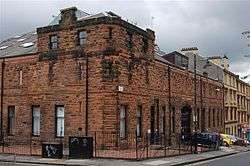Drill hall

A drill hall is a place such as a building or a hangar where soldiers practice and perform military drill.
Description
In the United Kingdom and Commonwealth, the term was used for the whole headquarters building of a military reserve unit, which usually incorporated such a hall. Many of these drill halls were built through public subscriptions in order to support the local Volunteer Force which was raised in the late 1850s.[1] In the United Kingdom, these were later renamed Territorial Army (TA) Centres and later Army Reserve Centres (ARC)s.[2] As well as a drill hall itself, they now usually feature other facilities such as a gymnasium, motor transport department, lecture rooms, stores, an armoury, administrative offices and the Officer's, Warrant Officers and Senior NCOs, and Junior Ranks Messes. Some Officer Training Corps, Army Cadet Force and Air Training Corps units are also co-located on the site of modern Army Reserve Centres, for example Blackheath drill hall.[3]
See also
References
- ↑ "Denbigh drill hall". Coflein. Retrieved 15 July 2017.
- ↑ "Galashiels, Paton Street, Mid Mill". Canmore. Retrieved 13 June 2017.
- ↑ "Drill Hall Register: A list of the locations of London Drill Halls since 1908" (PDF). Retrieved 14 May 2017.
Further reading
- Osborne, Mike, 2006. Always Ready: The Drill Halls of Britain's Volunteer Forces, Partizan Press, Essex. ISBN 1-85818-509-2
External links
![]()